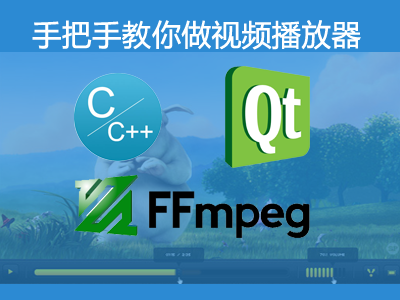FFmpeg3最新的解碼接口avcodec_send_packet和avcodec_receive_frame分析
ffmpeg3版本的解碼接口做了不少調整,之前的視頻解碼接口avcodec_decode_video2和avcodec_decode_audio4音頻解碼被設置為deprecated,對這兩個接口做了合並,使用統一的接口。並且將音視頻解碼步驟分為了兩步,第一步avcodec_send_packet,第二步avcodec_receive_frame,通過接口名字我們就可以知道第一步是發送編碼數據包,第二步是接收解碼後數據。新版本是否只是做了接口的變化,還有有哪些我們需要註意的事項,我們來分析一下。
首先我們先看一下這兩個接口。
avcodec_send_packet
接口源碼
/**
* Supply raw packet data as input to a decoder.
* Internally, this call will copy relevant AVCodecContext fields, which can
* influence decoding per-packet, and apply them when the packet is actually
* decoded. (For example AVCodecContext.skip_frame, which might direct the
* decoder to drop the frame contained by the packet sent with this function.)
* @warning The input buffer, avpkt->data must be AV_INPUT_BUFFER_PADDING_SIZE
* larger than the actual read bytes because some optimized bitstream
* readers read 32 or 64 bits at once and could read over the end.
*
* @warning Do not mix this API with the legacy API (like avcodec_decode_video2())
* or in future libavcodec versions.
*
* @note The AVCodecContext MUST have been opened with @ref avcodec_open2()
* before packets may be fed to the decoder.
*
* @param avctx codec context
* @param[in] avpkt The input AVPacket. Usually, this will be a single video
* frame, or several complete audio frames.
* Ownership of the packet remains with the caller, and the
* decoder will not write to the packet. The decoder may create
* a reference to the packet data (or copy it if the packet is
* not reference-counted).
* Unlike with older APIs, the packet is always fully consumed,
* and if it contains multiple frames (e.g. some audio codecs),
* will require you to call avcodec_receive_frame() multiple
* times afterwards before you can send a new packet.
* It can be NULL (or an AVPacket with data set to NULL and
* size set to 0); in this case, it is considered a flush
* packet, which signals the end of the stream. Sending the
* first flush packet will return success. Subsequent ones are
* unnecessary and will return AVERROR_EOF. If the decoder
* still has frames buffered, it will return them after sending
* a flush packet.
*
* @return 0 on success, otherwise negative error code:
* AVERROR(EAGAIN): input is not accepted right now - the packet must be
* resent after trying to read output
* AVERROR_EOF: the decoder has been flushed, and no new packets can
* be sent to it (also returned if more than 1 flush
* packet is sent)
* AVERROR(EINVAL): codec not opened, it is an encoder, or requires flush
* AVERROR(ENOMEM): failed to add packet to internal queue, or similar
* other errors: legitimate decoding errors
*/
int avcodec_send_packet(AVCodecContext *avctx, const AVPacket *avpkt);
參數分析
AVCodecContext *avctx:第一個參數與舊的接口一致,是視頻解碼的上下文,包含解碼器。
const AVPacket *avpkt: 編碼的音視頻幀數據
為什麽要傳遞空的avpkt
這裏有一個說明是可以傳遞NULL,什麽情況下需要傳遞NULL,你平時看一些視頻播放器,播放經常會少最後幾幀,很多情況就是因為沒有處理好緩沖幀的問題,ffmpeg內部會緩沖幾幀,要想取出來就需要傳遞空的AVPacket進去。
avcodec_receive_frame
接口源碼
/**
* Return decoded output data from a decoder.
*
* @param avctx codec context
* @param frame This will be set to a reference-counted video or audio
* frame (depending on the decoder type) allocated by the
* decoder. Note that the function will always call
* av_frame_unref(frame) before doing anything else.
*
* @return
* 0: success, a frame was returned
* AVERROR(EAGAIN): output is not available right now - user must try
* to send new input
* AVERROR_EOF: the decoder has been fully flushed, and there will be
* no more output frames
* AVERROR(EINVAL): codec not opened, or it is an encoder
* other negative values: legitimate decoding errors
*/
int avcodec_receive_frame(AVCodecContext *avctx, AVFrame *frame);
參數分析
AVCodecContext *avctx:第一個參數視頻解碼的上下文,與上面接口一致。
AVFrame *frame:解碼後的視頻幀數據。
空間申請和釋放問題
解碼後圖像空間由函數內部申請,你所做的只需要分配 AVFrame 對象空間,如果你每次調用avcodec_receive_frame傳遞同一個對象,接口內部會判斷空間是否已經分配,如果沒有分配會在函數內部分配。
avcodec_send_packet和avcodec_receive_frame調用關系並不一定是一對一的,比如一些音頻數據一個AVPacket中包含了1秒鐘的音頻,調用一次avcodec_send_packet之後,可能需要調用25次 avcodec_receive_frame才能獲取全部的解碼音頻數據,所以要做如下處理:
int re = avcodec_send_packet(codec, pkt);
if (re != 0)
{
return;
}
while( avcodec_receive_frame(codec, frame) == 0)
{
//讀取到一幀音頻或者視頻
//處理解碼後音視頻 frame
}
更多的資料也可以關註我51CTO上的視頻課程
夏老師的課堂 http://edu.51cto.com/lecturer/index/user_id-12016059.html
手把手教您開發視頻播放器
http://edu.51cto.com/course/course_id-8059.html

本文出自 “夏曹俊” 博客,轉載請與作者聯系!
FFmpeg3最新的解碼接口avcodec_send_packet和avcodec_receive_frame分析
